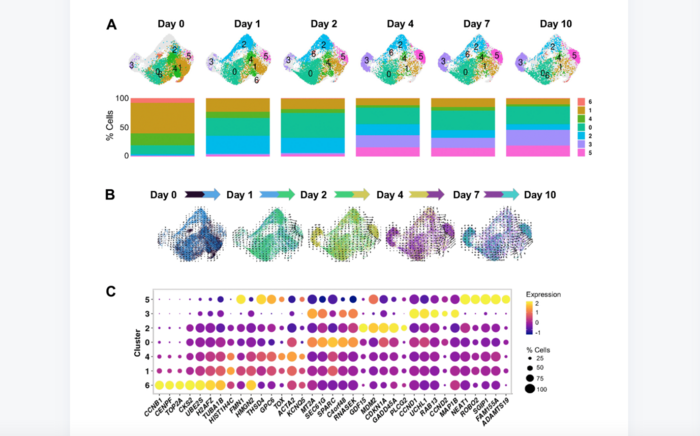“In summary, single-cell transcriptomic analysis has allowed us to identify the specific populations and the dynamic transition states during senescence initiation and progression.”

Credit: 2023 Wechter et al.
“In summary, single-cell transcriptomic analysis has allowed us to identify the specific populations and the dynamic transition states during senescence initiation and progression.”
BUFFALO, NY- May 9, 2023 – A new research paper was published in Aging (listed by MEDLINE/PubMed as “Aging (Albany NY)” and “Aging-US” by Web of Science) Volume 15, Issue 8, entitled, “Single-cell transcriptomic analysis uncovers diverse and dynamic senescent cell populations.”
Senescence is a state of enduring growth arrest triggered by sublethal cell damage. Given that senescent cells actively secrete proinflammatory and matrix-remodeling proteins, their accumulation in tissues of older persons has been linked to many diseases of aging. Despite intense interest in identifying robust markers of senescence, the highly heterogeneous and dynamic nature of the senescent phenotype has made this task difficult.
In this new study, researchers Noah Wechter, Martina Rossi, Carlos Anerillas, Dimitrios Tsitsipatis, Yulan Piao, Jinshui Fan, Jennifer L. Martindale, Supriyo De, Krystyna Mazan-Mamczarz, and Myriam Gorospe from the National Institute on Aging set out to comprehensively analyze the senescent transcriptome of human diploid fibroblasts at the individual-cell scale by performing single-cell RNA-sequencing analysis through two approaches.
“Here, we used single-cell RNA sequencing (scRNA-seq) analysis to document both the diverse transcriptomes of human senescent fibroblasts at an individual-cell scale, and the changes in the transcriptome over time during etoposide-triggered senescence.”
First, the researchers characterized the different cell states in cultures undergoing senescence triggered by different stresses, and found distinct cell subpopulations that expressed mRNAs encoding proteins with roles in growth arrest, survival and the secretory phenotype. Second, they characterized the dynamic changes in the transcriptomes of cells as they developed etoposide-induced senescence; by tracking cell transitions across this process, the researchers found two different senescence programs that developed divergently, one in which cells expressed traditional senescence markers such as p16 (CDKN2A) mRNA, and another in which cells expressed long noncoding RNAs and splicing was dysregulated. Finally, they obtained evidence that the proliferation status at the time of senescence initiation affected the path of senescence, as determined based on the expressed RNAs.
“We propose that a deeper understanding of the transcriptomes during the progression of different senescent cell phenotypes will help develop more effective interventions directed at this detrimental cell population.”
Read the full study: DOI: https://doi.org/10.18632/aging.204666
Corresponding Authors: Krystyna Mazan-Mamczarz, Myriam Gorospe
Corresponding Emails: [email protected], [email protected]
Keywords: senescence, single-cell analysis, transcriptome
Sign up for free Altmetric alerts about this article: https://aging.altmetric.com/details/email_updates?id=10.18632%2Faging.204666
About Aging-US:
Launched in 2009, Aging publishes papers of general interest and biological significance in all fields of aging research and age-related diseases, including cancer—and now, with a special focus on COVID-19 vulnerability as an age-dependent syndrome. Topics in Aging go beyond traditional gerontology, including, but not limited to, cellular and molecular biology, human age-related diseases, pathology in model organisms, signal transduction pathways (e.g., p53, sirtuins, and PI-3K/AKT/mTOR, among others), and approaches to modulating these signaling pathways.
Please visit our website at www.Aging-US.com and connect with us:
- SoundCloud
- YouTube
- LabTube
Click here to subscribe to Aging publication updates.
For media inquiries, please contact [email protected].
Aging (Aging-US) Journal Office
6666 E. Quaker Str., Suite 1B
Orchard Park, NY 14127
Phone: 1-800-922-0957, option 1
###
Journal
Aging-US
DOI
10.18632/aging.204666
Method of Research
Data/statistical analysis
Subject of Research
Cells
Article Title
Single-cell transcriptomic analysis uncovers diverse and dynamic senescent cell populations
Article Publication Date
19-Mar-2023




